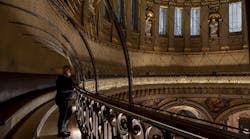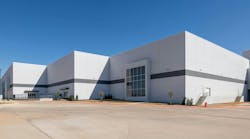LEDs Magazine caught up with Erin McDannald, CEO of Baltimore-based manufacturer’s representative, specification, and design services firm Lighting Environments, as well as the more recently launched Environments, an IoT technology integrator that has developed a software-driven digital twin of its business space. Developed during the early COVID-19 lockdown, the digital twin became a new service in its own right, with both companies leveraging the physical and virtual worlds to demonstrate how commercial clients can view, analyze, and revalue their buildings in a whole new way.
LEDs: Tell us a little bit about your background and how you came to launch Environments out of the parent company Lighting Environments.
McDannald: My background is in interior design. I made my way through the industry and got pulled into lighting pretty quickly after college. I grew up in the agency business. In 2020, our team at Lighting Environments launched Environments as an IoT-connected integration company. We were selling Enlighted and various other sensors; they were going into our fixtures, and we were connecting them to software and making them work. But we began to realize that integration was hard without having a software product, so we began to design our own software.
LEDs: Did you already have team members who had deep software engineering expertise?
McDannald: We didn't know anything about designing software, so we had to hire programmers. At first we hired outside programmers to help us build what we thought was just a kiosk software; we thought would make our lights [accessible] and we would put some cameras on and some thermostats, all networked under one app. I thought, “This can't be too hard.” Then we got into it and the project became much bigger.
We started adding video cameras, access controls, and everything that goes under an IoT layer, then analyzing to see how it worked. We were converging on other integrators that didn’t understand lights, but we understood lights. Still, they were putting their sensors in our lights and the channels just couldn’t converge. So in order for us to have a seamless transaction with a client, we had to become integrators and software developers.
LEDs: Initially, how did your firm utilize the software internally? How did it lead to merging data with developing a digital twin?
McDannald: We were selling sensors and trying to make sense of all the data coming in from the sensors. I couldn't figure out a return on the investment. It was something that we were taking online to sell, so I wanted to leverage this data. It requires the ego to let go of lights and think about how people interact in the space. Even then, lights are still very much the backbone of a digital IoT layer. That goes in between the physical world and the digital twin, which is a virtual space built to look exactly like your space, or the space that you’re designing for, wherever the operational technology layer is going in. It allows you to understand your data in a more spatial way.
Facilities management groups love digital twins, because they can understand where in the building things are going wrong. Maybe the sensors and lights or thermostats and HVAC aren't working [together]. With these floor plans connected to our facility’s IoT layer, we were pulling in data to the digital twin, such as people mapping, lux levels, and air quality levels, from the sensors. But how do they correlate?
We started to analyze data in spaces in a 360-degree way. At first we thought that our space was being utilized at 50% based on our people counters. But add in heat mapping sensors, and we learn that our employees are using 100% of our real estate. It meant that our employees were spreading out in our space, and we didn’t need to retract [our space]. We could probably use a walking track in our office, because people like to walk back and forth and spread out and move. The correlation of activities is a result of these real data scenarios that can influence the way our spaces are used.
LEDs: You’ve spoken in the industry about “building the future workplace in the metaverse.” Can you summarize how the metaverse became a part of your lighting and IoT business?
McDannald: The metaverse design came from taking our occupancy and usage trends in a new direction. We moved into a new physical office, pre-pandemic. Then we were sent home [during lockdown]; we couldn't use the showroom or sell in person. For Lighting Environments, we had this digital twin that we were pulling data from. I asked [the developers] if we could put people in there, and the answer was yes. So the question became: “If I can put people in there, can I use that digital space in the same way I use the physical space?” — which is for collaboration, to understand energy usage, and as a branded experience in the e-commerce realm.
At that point, we were trying to sell lights from the digital twin, as well as trying to understand the facilities management. All of those things can take place from one drawing that mimics your physical space. Because lighting is the largest electrical infrastructure in the building, that’s where we have all the sensors collecting the data that we can add to the digital twin. That's how we got into it.
LEDs: In terms of the control layer, is there a specific architecture or communications protocol that works best for you to manage the digital twin, and have all of the different devices in the network communicate properly?
McDannald: That's the greatest thing about the digital twin: It's your seamless interface between you and your client, but you could have 17 different systems behind it. You’d want to design it as streamlined as possible, but you could have separate phase-dimming, 0–10V, and DALI control systems in your building, but they can all appear to be the same control system under the digital interface. The backbone of your systems can be different. In our office, we have a Color Kinetics system on a Pharos programmer and then we have DALI to handle color tuning throughout the day.
In a streamlined front end, the digital twin’s interface provides data that goes beyond what we think of in the lighting industry. We're learning the desired lux levels for our employees, understanding noise levels, and even CO2 levels. Any sensor can be placed anywhere, but to have them under that one seamless integrated system is what the industry has needed for so long.
LEDs: How have employees reacted to using this virtual-world toolset?
McDannald: Well, at first I got a lot of resistance because I said the word “metaverse”! We're three years into the project, though. The one thing I advise all team members and clients first is to not use the word metaverse. We're just talking about taking our design, our Revit or designer’s drawings, and recreating them, then applying aspects of gaming to help us interface with data in a different way.
Out of 80 employees, we probably have five people who aren't really interested in going into the digital twin, and it usually breaks down by age. But those five people are hearing a lot about it, so some of them have become a bit more curious lately. We don't work in it all the time. We're purposeful about our work. We will be seated in there 24/7 shortly, but we've been trying out a lot of different things to see what will be meaningful. The digital twin is both a workplace for us and a showroom.
In the digital world, you can walk up to a window and see me in the physical world in real time. Imagine an avatar in a game-like setting that's a digital twin of my office or your office. You can walk up to your boss's door; you're looking at them through the virtual world and they’re actually in the physical world. You can see and talk to coworkers in real time. You get this immediate connection to people in creating these cohesive work environments.
LEDs: What is next for Lighting Environments and Environments?
McDannald: There are a few directions we’re pursuing. We're getting direct interest from new clients, which opens a new avenue for us as reps in the end user sector, helping to create these experiences for business owners. Like we have, they could generate income from their digital twins, understand how their workplace works, understand how human behavior works within their spaces, and how their real estate is utilized.
We’re going to spend a lot of time [with clients] in the commercial workplace, because we think that's the biggest opportunity. We have connected the physical and virtual world. With that in mind, we are showing clients around; we usually go from Zoom [meetings] to the metaverse. Their first reaction is often that they can stretch out, even though we're still behind computers. We don't use virtual reality glasses or headsets; we're navigating with our keyboards or our mouse.
It is interesting how this user experience drives lighting decisions. When the lights provide that much data, it's a lot easier to defend a higher price point because the ROI is there and more quickly evaluated.
LEDs: Do you find that post-pandemic, customers are more interested now in exploring occupancy, usage, and behavior, and finding ways to utilize that data strategically?
McDannald: I do. There are many businesses retracting in real estate. I was at the Cisco headquarters in One Penn Plaza [this past spring], and they said that they were [planning to sell] about 30% of their real estate. In our own business, we were at 50% occupancy, but we were using 100% of the office. We have to be thoughtful about how we measure usage and all the data points. I do think there are a lot of people who are scrutinizing because they're looking to offload real estate if it will save them money.
We got our start with intelligent spaces in the distribution sector. We had clients who wanted to understand where their forklifts were, and if their refrigerators were cooled to the proper levels. They wanted to know how their stock moves and if they're optimizing their space. That came in the middle of the pandemic; that was our first foray into digital twins and understanding how to mirror the physical and digital worlds. It put us into the workplace. And distribution has been in expansion mode since the pandemic, because as a society, we've changed the way we work and live. It’s the same for the workplace. We're just trying to make intelligent but costly decisions about real estate. So it begs for some substantive information before you make those decisions.
There's plenty to learn: Do your employees tend to sit near daylight or do they shy away from that? What are the lux levels, the foot-candle levels, in a particular space? Is there glare or is there a hot spot in the office?
This is a great way to measure people and be anonymous. You just measure how people behave and where they sit in your space; and maybe which teams collaborate and how they use this space when they work together. What design decisions can you make from that? It seems so simple when you think about a layer of lights and a few sensors, but they can create big storylines for you to act upon.
We can scale this out to campuses and cities, too. You can create a whole smart city with a digital twin and understand the workings of building campuses and different areas as well. You can scan the campus with lidar and put it in a drawing, then create a gamified version of it.
When I sit and think about what buildings are utilized and what the traffic patterns are, the sky’s the limit.
LEDs: It's not just a workflow tool for your team, then. It gives you the ability to control the physical environment to the point that it's comfortable, safe, and well utilized, while allowing you to redistribute resources. You can then utilize the virtual space as a way to demonstrate to customers what's possible.
McDannald: Right! What I imagine we are going to find is how much income real estate generates for businesses, whether it be in the digital or physical world, as a result of incorporating a digital twin. If you're a developer or building owner and you build a digital twin, offer that to your tenants. Those owners could begin to generate income from those digital twins because they're able to make more informed decisions, sell in different ways, and save money on utilities, which trickles down into the tenant decisions and savings.
A decision to move to another space when the lease is up becomes that much more weighted because you have more real estate space [with the digital twin] and you’re using it in the same ways [as the physical space].
I have found, though, that the lighting industry is slow to catch on because it requires you to understand [the IoT] as a system and lighting as a backbone to the system that creates these experiences. [At Lighting Environments and Environments], we do this for a living: We put sensors in our lights, and we put together lighting controls systems; we're used to that being the center of the experience. As lighting professionals, we love that. But we have to understand that it could also be the digital backbone to our intelligence systems, which doubles the value of lighting. That's the important thing to take away, lighting is both front and center as well as the backbone of your digital layer within the space.
This interview has been condensed and edited for clarity.
CARRIE MEADOWS is editor-in-chief of LEDs Magazine, with 20-plus years’ experience in business-to-business publishing across technology markets including solid-state technology manufacturing, fiberoptic communications, machine vision, lasers and photonics, and LEDs and lighting.
Follow our LinkedIn page for our latest news updates, contributed articles, and commentary, and our Facebook page for events announcements and more. You can also find us on the X platform.







